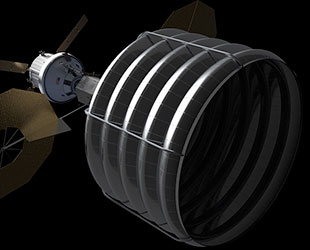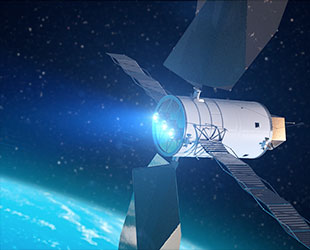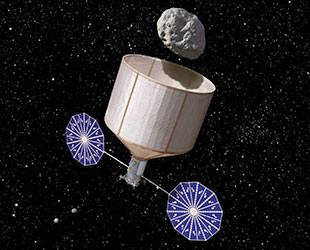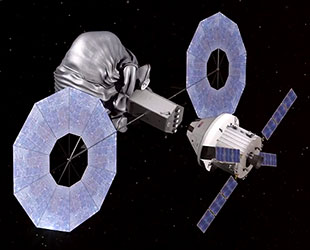April 10, 2013 — NASA may have found a shortcut to sending its astronauts to an asteroid. Rather than finding a suitably-sized space rock passing close enough to Earth, the agency may snag one and move it to within its reach.
The plan, which was formally revealed Wednesday (April 10) as part of President Barack Obama's 2014 fiscal year budget proposal, advances the president's goal of sending a manned mission to a near-Earth asteroid by 2025 and then to Mars in the 2030's. The strategy addresses both the budgetary and technical issues NASA has been facing since the goals were first set by the president three years ago, while also advancing the agency's efforts to protect the planet from objects that cross Earth's orbit.
"The budget includes $78 million for NASA to develop needed technologies and study alternative approaches for a robotic mission to rendezvous with a small asteroid — one that would be harmless to Earth — and move it to a stable location outside the Moon's orbit," the White House Office of Management and Budget wrote in a summary of NASA's 2014 funding request.

Notional concept for an asteroid capture spacecraft. (NASA/ACL) |
The project, which has yet to be named, brings together NASA's science, space technology and human exploration and operations directorates and leverages existing efforts, including asteroid identification, the development of solar electric propulsion for the transport of the targeted rock, and the Space Launch System (SLS) with the Orion multi-purpose crew vehicle for the mission to send astronauts to explore and even mine the captured boulder.
"This mission represents an unprecedented technological feat," NASA Administrator Charles Bolden said in a press release issued Wednesday. "[It] will lead to new scientific discoveries and technological capabilities and help protect our home planet."
Three-step approach
As outlined by NASA, the asteroid capture mission will be achieved in three segments: identification, redirection and exploration.
According to the space agency's notional timeline, efforts to detect and identify a target rock could begin this year and continue through 2016. Ground telescopes, including the Palomar Observatory in California and Pan-STARRS — the Panoramic Survey Telescope and Rapid Response System — would begin the search, which could later be enhanced by observations made by a geostationary Earth orbit satellite.

The use of advanced solar electric propulsion technologies like this concept could enable NASA to find, rendezvous, capture and relocate an asteroid. (NASA/Analytical Mechanics Associates) |
The search needs to take into consideration the asteroid's trajectory, its size, spin rate, and its composition. Ideally, NASA would seek a target rock that is 23 to 33 feet wide (7 to 10 meters) and about 500 tons (450,000 kilograms).
The target asteroid's relative small size not only makes its capture and move possible, but also ensures that were it to somehow stray off-course, it would be destroyed by the Earth's atmosphere before ever reaching the ground.
As an appropriate asteroid is identified, NASA may adapt a planned mission to demonstrate light-weight solar arrays and solar electric propulsion (SEP) to validate the robotic technologies needed to capture and move the target body. That mission could launch in 2017, according to NASA's preliminary timeline.
The actual rendezvous and lassoing of an asteroid, which NASA characterizes as the "most technically challenging aspect of the mission," could begin as soon as 2019 and result in the asteroid arriving in the vicinity of the moon in 2021.

Artist's illustration of an asteroid retrieval spacecraft capturing a 500-ton asteroid. (Rick Sternbach/Keck Institute for Space Studies) |
The robotic spacecraft to achieve that task still needs to be designed, but it could feature solar arrays and a large container to surround the space rock and push it closer to the Earth.
The manned mission to explore the asteroid would take the place of a planned crewed flight of the Orion capsule, which was originally slated to send astronauts to orbit the moon in an extended test of the spacecraft's life support systems. Instead, the EM-2 mission would fly astronauts past Earth's nearest neighbor to the asteroid, where crew members could collect significant scientific samples.
Risk and reward
The mission, as proposed, combines efforts to protect the planet, advance exploration capabilities and technologies for human spaceflight, and learn how to best utilize space resources.

Animation still showing a NASA Orion crew capsule flying near an asteroid retrieval spacecraft in the moon's vicinity. (NASA) |
The proposal comes at a time when U.S. companies have proposed mining asteroids, and just two months after an asteroid — the largest known body to strike the Earth in a century — exploded over Russia, leaving hundreds injured and raising concerns worldwide about the risks asteroids hold for the future of life on Earth.
"We're working with international partners, academia, and everybody else and we feel very confident that not only will we be a step closer to putting humans with an asteroid and getting humans to Mars, but we will finally answer the question can humans do something to protect the planet," Bolden said in a press conference.
The mission would give astronauts the experience working in deep space needed for the goal of sending humans to Mars, and solve a problem NASA was facing with finding an asteroid close enough to be able to deliver astronauts there by the president's 2025 deadline.
